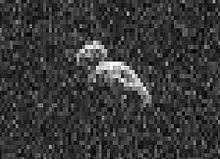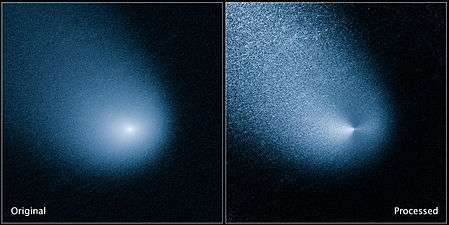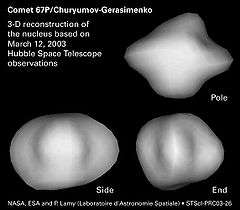Chang'e 5-T1
 Chang'e 5-T1's re-entry module after vacuum thermal tests | |
| Mission type | Chang'e 5 precursor mission, lunar flyby and Earth reentry |
|---|---|
| Operator | CNSA |
| COSPAR ID | 2014-065A |
| SATCAT № | 40283 |
| Mission duration |
Primary Mission: 8.17 days Extended Mission: 774 days |
| Spacecraft properties | |
| Bus | DFH-3A [1] |
| Manufacturer | CAST |
| Start of mission | |
| Launch date | 23 October 2014, 18:00 UTC [2][3] |
| Rocket | Long March 3C/G2 |
| Launch site | Xichang LC-2 |
| End of mission | |
| Landing date |
31 October 2014, 22:42 UTC[4][5] Return capsule |
| Landing site | Siziwang Banner, Inner Mongolia |
| Orbital parameters | |
| Reference system | Geocentric |
| Regime | Lunar free return |
Chang'e 5-T1 (Chinese: 嫦娥五号T1; pinyin: Cháng'é wǔhào T1) is an experimental unmanned lunar mission that was launched on 23 October 2014 by the China National Space Administration (CNSA) to conduct atmospheric re-entry tests on the capsule design planned to be used in the Chang'e 5 mission.[2][6][7] As the final part of the Chinese Lunar Exploration Program, Chang'e 5, scheduled for 2017, will be a Moon sample return mission. Like its predecessors, the spacecraft is named after the Chinese Moon goddess Chang'e.
- Xiaofei, literally means "little flyer" in Chinese, the return capsule of Chang'e 5-T1, landed in Siziwang Banner, Inner Mongolia on 31 October 2014, 22:42 UTC.
- CE-5-T1 Service Module entered lunar orbit[8] by January 13, 2015 - initial orbit is 200 x 5300 km with period of 8 hours.
Characteristics
It consisted of a DFH-3A "Chang'e 2 type" spacecraft featuring the Chang'e 5 return capsule, launched by a Long March 3C rocket into a lunar free return trajectory. It looped behind the Moon and returned to Earth, with the return capsule testing the high speed atmospheric skip reentry. The DFH-3A "service module" remained in orbit around the Earth before being relocated via Earth-Moon L2 to lunar orbit by 13 January 2015, where it will use its remaining 800 kg of fuel to test maneuvers key to future lunar missions.[9]
In February and March the DFH-3A "service module" will perform 2 "virtual target" rendezvous tests for the future CE-5 mission. In April 2015 the small monitoring camera will be used to obtain higher resolution photos of CE-5's landing zone.
Mission profile
- Launch: Xichang Satellite Launch Center, October 23, 2014, 18:00 UTC
- Nominal mission duration: Chang'e 5 return capsule: 196 hours (8.17 days)
- Nominal mission duration: DFH-3A: Ongoing
- Lunar fly-by: 97 hours after final orbit insertion (4.04 days)
- Periselenium: ~13,000 km from Moon surface
- Distance of Moon from Earth at closest fly-by: ~373,000 km[10][11][12]
- Landing: Siziwang Banner, Inner Mongolia, 31 October 2014, 22:42 UTC
Secondary payloads
Chang'e 5-T1 also carries the first commercial mission to the moon[13] called the 4M mission (Manfred Memorial Moon Mission) for the German space technology company, OHB System, in honor of the company's founder, Professor Manfred Fuchs, who died in 2014. Technical management of the 4M mission was performed by LuxSpace. The payload weighs 14 kilograms and contains two scientific instruments. The first instrument is a radio beacon to test a new approach for locating spacecraft. Amateur radio operators were encouraged via prize incentives to receive the transmissions and send results back to LuxSpace.[14] The second instrument, a radiation dosimeter provided by the Spanish company iC-Málaga, continuously measured radiation levels throughout the satellite's circumlunar path.[15][16]
The spacecraft also carries a radiation exposure experiment with bacteria and plants.[1][17][18]
See also
- Chinese space program
- Exploration of the Moon
- List of missions to the Moon
- Robotic exploration of the Moon
References
- 1 2 "Chang'e 5-T1 (CE 5-T1)". Gunter's Space Page. 23 October 2014. Retrieved 2014-10-23.
- 1 2 "Chinese Long March Rocket successfully launches Lunar Return Demonstrator". Spaceflight101. Oct 23, 2014.
- ↑ "China launches test return orbiter for lunar mission". Xinhuanet. Oct 24, 2014.
- ↑ "China completes first mission to moon and back". Space Daily. November 1, 2014. Retrieved 2014-11-01.
- ↑ "中国探月工程三期再入返回飞行试验获圆满成功". 中国新闻网. Oct 31, 2014.
- ↑ "CLunar mission:craft to conduct re-entry tests before 2015". Xinhuanet. Dec 14, 2013.
- ↑ "China's Lunar Probe Tester Ready for Chang'e 5 Mission". CRIEnglish News. Aug 11, 2013.
- ↑ http://news.xinhuanet.com/english/china/2015-01/13/c_133915882.htm
- ↑ "Chang'e 5 Test Mission Updates". Spaceflight 101. Retrieved 14 December 2014.
- ↑ "The mission". LuxSpace.
- ↑ "ANS-278 AMSAT News Service Weekly Bulletins". AMSAT News Service. Oct 5, 2014.
- ↑ "天津航天爱好者谈嫦娥五号飞行试验器". Retrieved 26 October 2014.
- ↑ "First commercial mission to the moon launched from China". Spaceflight Now. 25 October 2014. Retrieved 24 July 2015.
- ↑ "4M Reception Contest". LuxSpace.
- ↑ "China Readies Moon Mission for Launch Next Week". Space.com. Oct 14, 2014.
- ↑ "China Poised to Launch Next Moon Mission on Thursday". Space.com. Oct 22, 2014.
- ↑ Aron, Jacob (20 October 2014). "China set to launch probe on round trip to the moon". New Scientist. Retrieved 2014-10-28.
- ↑ Barbosa, Rui C. (23 October 2014). "China launches lunar sample return test mission". NASA Space Flight.
External links
- Manfred Memorial Moon Mission (4M) - official website for secondary payload at Chang'e 5-T1
- Pocket Spacecraft - Space exploration for everyone - official website for another secondary payload at Chang'e 5-T1




